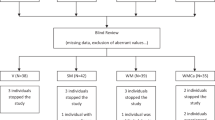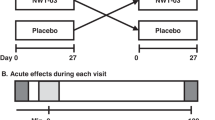Abstract
Objective:
To determine the cholesterol-lowering efficacy of hydroxypropylmethylcellulose (HPMC) in mildly hypercholesterolemic humans.
Subjects:
Trial one: entry mean (range) total serum cholesterol values of eight female and four male subjects were 6.48 (5.57–7.51) mmol l−1 (250 (215–290) mg dl−1) and 6.60 (5.57–7.64) mmol l−1 (255 (215–295) mg dl−1), respectively. Trial two: corresponding values for 20 women and 20 men were 5.96 (5.43–6.48) mmol l−1 230 (210–250) mg dl−1) and 6.05 (5.46–6.63) mmol l−1 233 (211–256) mg dl−1), respectively.
Results:
Trial one: HPMC decreased (P⩽0.05) total and LDL-cholesterol 9.3 and 15.3% (medium), 16.9 and 23.5% (high) and 13.8 and 19.4% (ultra-high), respectively, over placebo. Trial two: total and LDL-cholesterol decreased (P⩽0.05) throughout the 8 weeks, with mean (weeks 4–8) reductions of 7 and 8% at 5 g day−1, and 12 and 15% at 15 g day−1, respectively, over placebo. Adverse effects were minimal. Trial one: medium, high and ultra-high viscosity HPMC at 15 g day−1 for 1 week each;1-week wash-out between treatments. Trial two: ultra-high viscosity HPMC at 5 or 15 g day−1 for 8 weeks.
Conclusions:
HPMC soluble fiber, especially high-viscosity grades, significantly lowers cholesterol at well-tolerated doses, showing promise as a treatment of hypercholesterolemia.
This is a preview of subscription content, access via your institution
Access options
Subscribe to this journal
Receive 12 print issues and online access
$259.00 per year
only $21.58 per issue
Buy this article
- Purchase on Springer Link
- Instant access to full article PDF
Prices may be subject to local taxes which are calculated during checkout
Similar content being viewed by others
References
Benko S, Szabo R, Varga L, Szarvas F (1970). A study of vascular lesions induced by cholesterol feeding and methylcellulose administration in rabbits. Examination of the total lipid and TC level in the serum and several organs. Cor Vasa 12, 65–74.
Braun WH, Ramsey JC, Gehring PJ (1974). The lack of significant absorption of methylcellulose, viscosity 3300 Cp, from the gastrointestinal tract following single and multiple oral doses to the rat. Food Cosmet Toxicol 12, 373–376.
Carr TP, Gallaher DD, Yang CH, Hassel CA (1996). Increased intestinal contents viscosity reduces cholesterol absorption efficiency in hamsters fed hydroxypropyl methylcellulose. J Nutr 126, 1463–1469.
Deshmukh B, Harfmann RG, Conklin J, Turowski M, Lynch S (2007). Validation of a size exclusion liquid chromatographic method for determination of methylcellulose and hydroxypropyl methylcellulose food gums as soluble dietary fiber in food and food product. Food Chem 104, 852–857.
Dressman JB, Adair CH, Barnett JL, Berardi RR, Dunn-Kucharski VA, Jarvenpaa KM et al. (1993). High-molecular-weight hydroxypropylmethylcellulose. A cholesterol-lowering agent. Arch Intern Med 153, 1345–1353.
Gallaher DD, Hassel CA, Lee KJ (1993a). Relationships between viscosity of hydroxypropyl methylcellulose and plasma cholesterol in hamsters. J Nutr 123, 1732–1738.
Gallaher DD, Hassel CA, Lee KJ, Gallaher CM (1993b). Viscosity and fermentability as attributes of dietary fiber responsible for the hypocholesterolemic effect in hamsters. J Nutr 123, 244–252.
Harfmann RG, Deshmukh BK, Conklin JR, Turowski M, Lynch SK (2007). Determination of methylcellulose and hydroxypropyl methylcellulose food gums in food and food products: collaborative study. J AOAC Int 90, 786–793.
Machle W, Heyroth FF, Witherup S (1944). The fate of methylcellulose in the human digestive tract. J Biol Chem 153, 551–559.
Maki KC, Davidson MH, Malik KC, Albecht HH, O'Mullane J, Daggy BP (1999). Cholesterol lowering with high-viscosity hydroxypropylmethylcellulose. Am J Cardiol 84, 1198–1203.
Maki KC, Davidson MH, Torri S, Ingram KA, O'Mullane J, Daggy BP et al. (2000). High-molecular-weight hydroxypropylmethylcellulose taken with or between meals is hypocholesterolemic in adult men. J Nutr 130, 1705–1710.
McCollister SB, Kociba RJ, McCollister DD (1973). Dietary feeding studies of methylcellulose and hydroxypropylmethylcellulose in rats and dogs. Food Cosmet Toxicol 11, 943–953.
Nitschke K, Fiero T (1977). The metabolism of methylcellulose gums. In: Hood L, Wardrip E, Bollenback G (eds). Carbohydrate and Health. AVI Publishing Co: Westport, CT, pp 57–68.
Santos EM (1986). Expert panel, final report on the safety assessment of hydroxyethylcellulose, hydroxypropylcellulose, methylcellulose, hydroxypropyl methylcellulose, and cellulose gum. J Am Coll Toxicol 5, 1–59.
Spiller RC (1994). Pharmacology of dietary fibre. Pharmacol Ther 62, 407–427.
Swidan SZ, Reppas C, Barnett JL, Greenwood DE, Tallman AM, Tobey SW et al. (1996). Ability of two comestible formulations of hydroxypropylmethylcellulose to lower serum cholesterol concentrations. Eur J Pharm Sci 4, 239–245.
Turowski M, Deshmukh BK, Harfmann RG, Conklin JR, Lynch S (2007). A method for determination of soluble dietary fiber in methylcellulose and hydroxypropyl methylcellulose food gums. J Food Comp Anal 20, 420–429.
United States Food and Drug Administration (1997). FDA final rule for federal labeling: health claims; oats and coronary heart disease. Fed Regist 62, 3584–3681.
United States Pharmacopeia: The National Formulary (2003). Monograph USP26-NF21 for Hypromellose. United States Pharmacopeial Convention Inc.: Rockville, MD.
Van de Kamer JH (1958). Total fatty acids in stool. In: Seligson D (ed). Standard Methods of Clinical Chemistry, vol. 2 Academic Press: New York, pp 34–38.
Yokoyama WH, Knuckles BE, Davis PA, Daggy BP (2002). Stability of ingested methylcellulose in the rat determined by polymer molar mass measurements by light scattering. J Agric Food Chem 50, 7726–7730.
Acknowledgements
We thank Cora J Dillard for her excellent editorial assistance in preparing this article. Sponsorship: University of Michigan and Dow Chemical Company.
Author information
Authors and Affiliations
Corresponding author
Additional information
Contributors: CR assisted with the study concept and design, ran the studies in the University of Michigan CRC together with SZS, and participated in data analysis and interpretation (current affiliation National and Kapodistrian University of Athens, Faculty of Pharmacy, Panepistimiopolis, 157 71 Zografou, Greece); SZS ran the studies in the University of Michigan CRC together with CR, and participated in data analysis and interpretation (affiliation still current); SWT (now retired) assisted with the study concept and design and developed the HPMC formulations; MT assisted with data analysis and presentation and drafted the manuscript; JBD was principal investigator of the project (current affiliation: Institute of Pharmaceutical Technology, JW Goethe University, Frankfurt/Main, Germany). All authors reviewed and assented to the submission of the article.
Rights and permissions
About this article
Cite this article
Reppas, C., Swidan, S., Tobey, S. et al. Hydroxypropylmethylcellulose significantly lowers blood cholesterol in mildly hypercholesterolemic human subjects. Eur J Clin Nutr 63, 71–77 (2009). https://doi.org/10.1038/sj.ejcn.1602903
Received:
Revised:
Accepted:
Published:
Issue Date:
DOI: https://doi.org/10.1038/sj.ejcn.1602903
Keywords
This article is cited by
-
Cellulose ether treatment inhibits amyloid beta aggregation, neuroinflammation and cognitive deficits in transgenic mouse model of Alzheimer’s disease
Journal of Neuroinflammation (2023)
-
Rheological properties of milk-based desserts with the addition of oat gum and κ-carrageenan
Journal of Food Science and Technology (2019)
-
Cholesterol-Lowering Nutraceuticals Affecting Vascular Function and Cardiovascular Disease Risk
Current Cardiology Reports (2018)
-
Physical and Antimicrobial Properties of Tapioca Starch-HPMC Edible Films Incorporated with Nisin and/or Potassium Sorbate
Food and Bioprocess Technology (2013)
-
Hydroxypropylmethylcellulose lowers cholesterol in statin-treated men and women with primary hypercholesterolemia
European Journal of Clinical Nutrition (2009)



